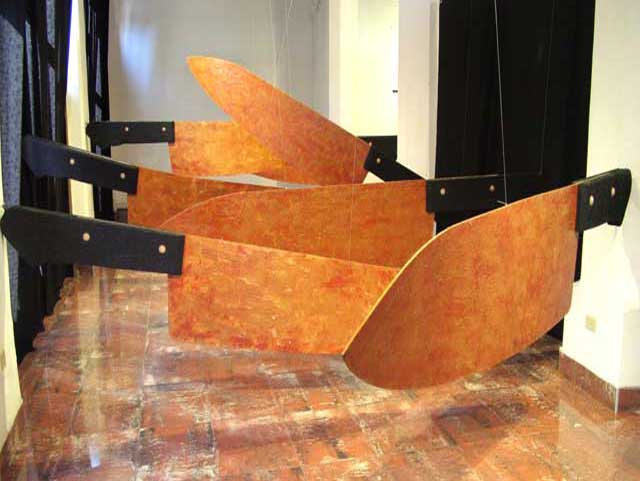Between immanence and transcendence: The Non-Place Labyrinth. From the series Exitus-Reditus, Cartography of the Self (Environmental Art)
Nothing more, Nothing less (Exitus-Reditus)
2005
Wood, coal and clay.
280 x 40 x 10 cm. each knife (variable dimensions Installation)
Installative work (Environmental Art) first shown at the Personal Exhibition “Exitus-Reditus, Cartography of the self”, Servando Gallery (Genesis Art Galleries), Havana.
House of The Labrys (Exitus Reditus): Lost to Be Found.
It doesn´t exist. Don’t expect anything. Not even
in the black twilight the beast.
Jorge Luis Borges
Labyrinth
Loss, misdirection: “Exitus Reditus, Nothing More, Nothing Less“, in the words of the author is a “manual for getting lost” which proposes a concept of existence as a constant pilgrimage along the paths of the self. A mystical labyrinth drawn with seven large knives -instruments designed to cut, sever, amputate- that the spectator must save by describing a zig-zag movement, while transferring something of himself to them. These sculptural pieces have been patinated with a resin that collects particles of clothing and other organic substances (hair, epithelials…) that the spectator leaves behind when walking through them.
Labyrinthine Thought: The Non-Place
This is a work that alternates and juxtaposes ideological considerations at the metaphysical, political and cultural levels; it builds bridges between the finite and the absolute; it takes place in a labyrinthine space that interweaves the mental and the social. It is a work that describes a path without stations that leads invariably to the non-place (not in the adverse sense conferred by Marc Augé), but more focused on the de-centralization of the place itself to derive in a psychogeographical location of encounter with the other (Martin Buber). In this way, the Labyrinth as a Spiritual Sphere and, in the knife (onmipresent allegory in the symbolic proposal of this artist), the always latent threat of in-formulated aggression… and scission.

